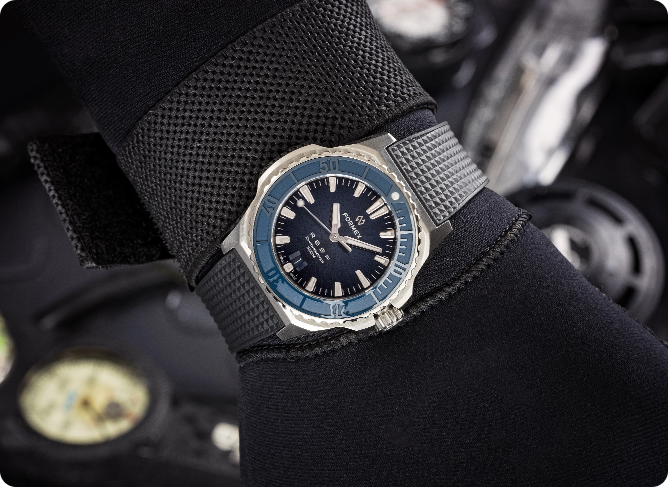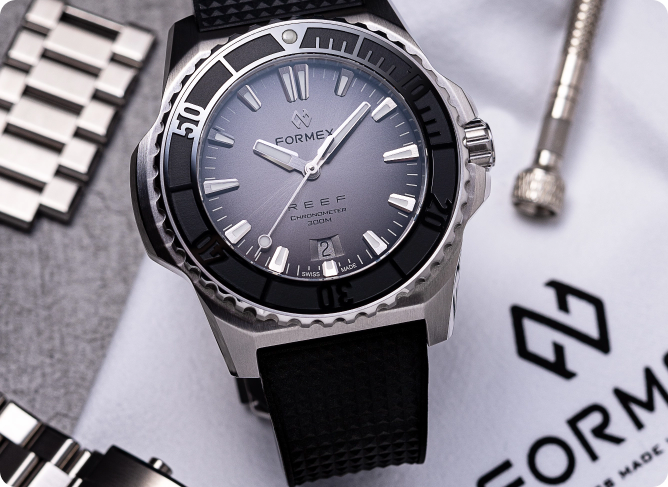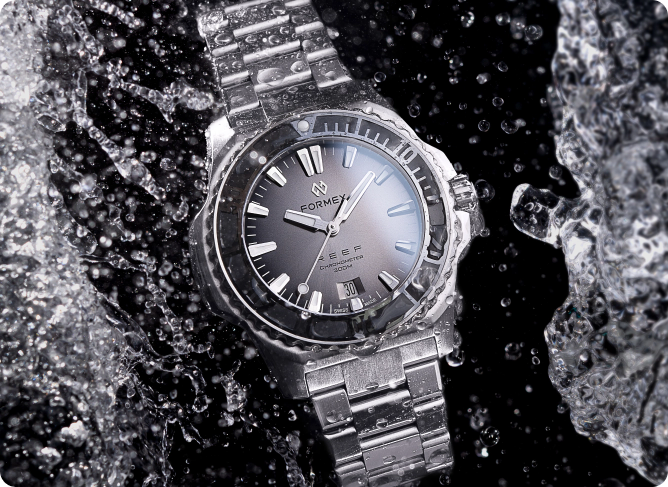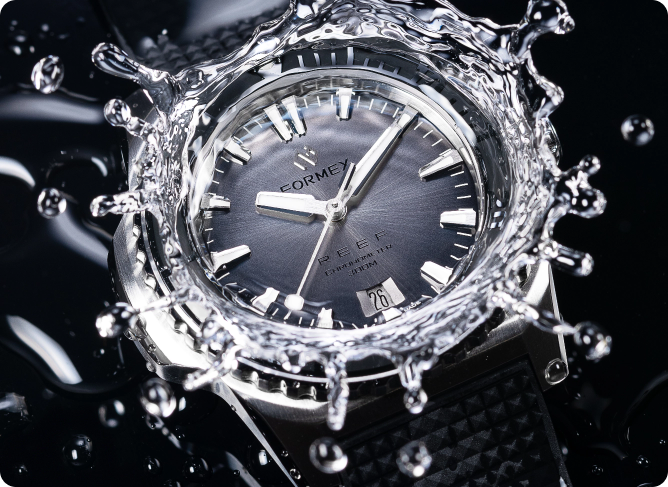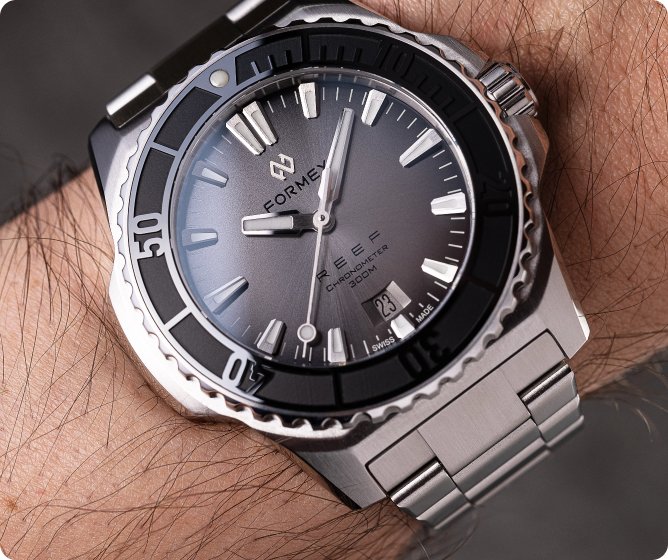Dive watches
Dive Watches
Built for life deep below the surface of the ocean.


The Formex Reef Dive Watch
The Formex Reef collection is the brand’s lineup of Swiss Made professional underwater timepieces. Measuring 42mm in diameter by 11.4mm thick, with a perceived height of just 9.4mm, the Formex Reef is crafted from durable and highly corrosion-resistant stainless steel, and it offers all of the hallmark features of a true dive watch, such as its unidirectional rotating timing bezel, a highly luminous Super-LumiNova display, and 300 meters (1,000 feet) of water resistance.
Additionally, the Formex Reef also features the brand’s innovative interchangeable bezel system, which allows users to instantly switch up the look of their diving watch without the use of any tools. Furthermore all of the clasps fitted to the various strap and bracelet options for the Reef collection include Formex’s fine adjustment system, which allows them to be instantly expanded or contracted to achieve the perfect fit, regardless of whether you are wearing your dive watch on your wrist or over the sleeve of a wetsuit.
While the original Formex Reef is a purpose-built professional dive watch, the Formex Reef GMT adds the additional functionality of being able to simultaneously display up to three different time zones, while still retaining the ability to withstand depths of up to 300 under water.

Not only can the interchangeable bezels be swapped between Formex Reef diver and Reef GMT watches, but all of the different straps and bracelets for the greater Reef collection are cross-compatible, and they can instantly be changed without the use of any tools.
Just as you would expect from any proper professional dive watch, the Formex Reef features a highly luminescent display. All three of the hands, plus each one of the hour markers is finished with BGW9 Super-LumiNova, which emits a strong, long-lasting blue glow to provide optimum legibility even in the darkest of waters. The Formex Reef offers one of the brightest glowing displays among all of the luxury dive watches on the market, and in a recent "lume war” video that compares the brightness and duration of various different watches luminous displays, the Formex Reef ranked number one.
Lastly, powering the Formex Reef is the COSC-certified Sellita SW300 self-winding movement, which features top of the line components only found in chronometer-grade calibers. Fitted with color-matched date wheels to offer a cohesive overall aesthetic, the chronometer-certified SW300 automatic movement inside the Formex Reef guarantees accurate and reliable performance, regardless of whether you are lounging on the beach or exploring a shipwreck deep below the waves.
The Formex Reef Dive Watch
However, within just a few years of the very first GMT watches making their inaugural appearances, this innovative style of travel-ready timepiece received a major update in the form of an additional hour hand being added to their dials. Now fitted with a secondary 12-hour hand, this follow-up generation of GMT watches allowed pilots to read the time in a traditional 12-hour format without sacrificing any of the GMT capabilities of their 24-hour dial predecessors.
The next major innovation arrived in the early 1980s, and it enabled the two hour hands to be set independently from each other. This drastically alters the functionality of modern GMT watches and enables them to display two different time zones with just their dials and hands, leaving their rotating bezels free to display a third. Since the 24-hour bezel is no longer a requirement for GMT functionality, today’s GMT watches are free to to take on a wide variety of different styles, making this highly useful complication even more practical than ever before.

With that in mind, not all watch clasps are the same, and different styles can offer different features and appearances, in addition to significantly impacting the overall fit and feel of your timepiece.
Dive Watch Key Features
Diving watches have been around for well over a half a century, and during that time, a wide variety of different examples have been produced by countless different brands throughout the industry. With that in mind, all dive watches are united by the same core set of features, although the specific style and the way that they are implemented can differ from one dive watch to the next.
A Brief History of the Divers Watch
Although diving watch companies have been trying to make water resistant timepieces since the very earliest days of the wristwatch, the first purpose-built dive watches didn’t make an appearance until the rise of scuba diving in the early 1950s. Although there are several documented instances of water resistant watches being ordered by various military units during the earliest days of underwater operations, the very first commercially available divers watches were released to the public in 1953.
Rolex, Blancpain, and Zodiac all unveiled dive watches that same first year, and the genre of underwater timepieces quickly gained popularity over the course of the next couple decades. By the late 1960s, the ability to seal a diving watch against moisture and dirt was well within many brand’s abilities, but new challenges stemming from the unique environments of saturation diving called for a new type of dive watch.
Different Types of Dive Watches
Although dive watches can come in many different shapes and forms, all of them are intended to perform the same core function, and that is to keep track of time while underwater. With that in mind, there are a few different types of dive watches, and each one corresponds to a different type of diving.


